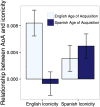Iconicity in English and Spanish and Its Relation to Lexical Category and Age of Acquisition
- PMID: 26340349
- PMCID: PMC4560417
- DOI: 10.1371/journal.pone.0137147
Iconicity in English and Spanish and Its Relation to Lexical Category and Age of Acquisition
Abstract
Signed languages exhibit iconicity (resemblance between form and meaning) across their vocabulary, and many non-Indo-European spoken languages feature sizable classes of iconic words known as ideophones. In comparison, Indo-European languages like English and Spanish are believed to be arbitrary outside of a small number of onomatopoeic words. In three experiments with English and two with Spanish, we asked native speakers to rate the iconicity of ~600 words from the English and Spanish MacArthur-Bates Communicative Developmental Inventories. We found that iconicity in the words of both languages varied in a theoretically meaningful way with lexical category. In both languages, adjectives were rated as more iconic than nouns and function words, and corresponding to typological differences between English and Spanish in verb semantics, English verbs were rated as relatively iconic compared to Spanish verbs. We also found that both languages exhibited a negative relationship between iconicity ratings and age of acquisition. Words learned earlier tended to be more iconic, suggesting that iconicity in early vocabulary may aid word learning. Altogether these findings show that iconicity is a graded quality that pervades vocabularies of even the most "arbitrary" spoken languages. The findings provide compelling evidence that iconicity is an important property of all languages, signed and spoken, including Indo-European languages.
Conflict of interest statement
Figures



References
-
- Plato. Cratylus Reprinted with corr. Indianapolis: Hackett; 1999.
-
- Hockett CF. The origin of speech. Sci Am. 1960;203: 88–96. - PubMed
-
- Taub SF. Language from the Body: Iconicity and Metaphor in American Sign Language. Cambridge University Press; 2001.
Publication types
MeSH terms
LinkOut - more resources
Full Text Sources
Other Literature Sources
Research Materials

